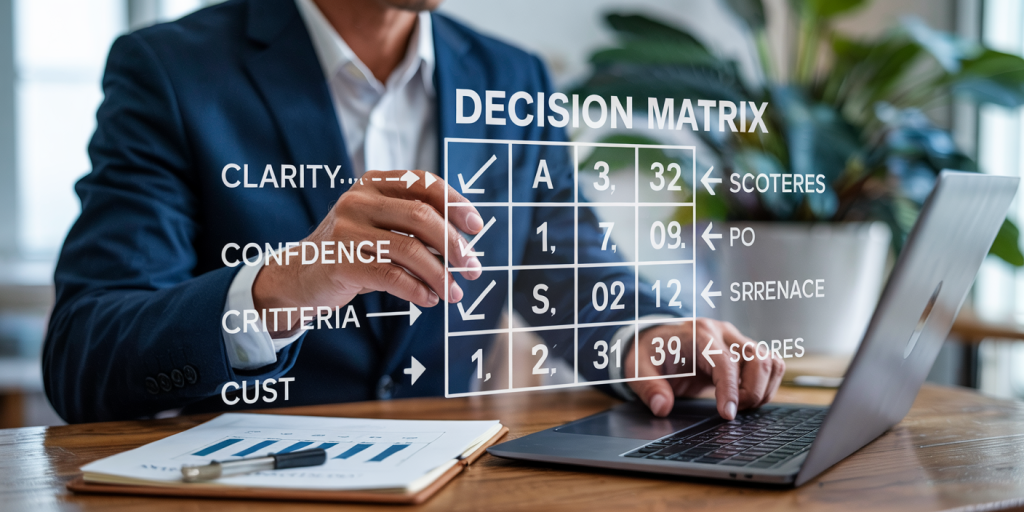How to Make Big Decisions with Clarity and Confidence
Every individual faces moments in life where big decisions can alter their trajectory profoundly. Whether it’s changing careers, investing in a business, relocating to a new city, or committing to a long-term partnership, the pressure to choose correctly is immense. Making these decisions with clarity and confidence isn’t just about gut feeling; it relies on structured thinking, psychological readiness, and strategic evaluation. This article explores practical methods, backed by research and real-world examples, showing you how to approach significant decisions methodically to achieve optimal outcomes.
The Anatomy of Big Decisions: Why Clarity and Confidence Matter
Big decisions are often characterized by their complexity, uncertainty, and the significant impact they have on one’s future. According to a 2018 Deloitte survey, 55% of professionals reported feeling overwhelmed when making major career decisions, which underscores how common decision paralysis is. Clarity helps distill complex options into understandable parts, while confidence enables decisive action rather than procrastination or doubt.
For example, consider Satya Nadella’s decision to steer Microsoft toward cloud computing. This was a high-stakes move that required deep clarity about market trends and confidence in diverting from legacy products. His success showcases how clarity and confidence, paired with research and vision, can transform a company’s fortunes dramatically.
A lack of clarity can lead to anxiety and poor outcomes. Studies at Harvard Business School have shown that indecision can reduce productivity by up to 20%, while overconfidence without clarity often results in costly mistakes. The key is balancing these two attributes; clarity without confidence stalls decision-making, and confidence without clarity can be reckless.
Developing a Framework for Decision-Making
Creating a structured framework is essential when tackling big choices. One of the most effective approaches is the decision matrix, which allows a balanced evaluation of options based on weighted criteria. For instance, if you’re choosing between job offers, criteria might include salary, growth opportunities, work-life balance, company culture, and location.
| Criteria | Weight (%) | Option A (Score x Weight) | Option B (Score x Weight) | Option C (Score x Weight) |
|---|---|---|---|---|
| Salary | 30 | 8 x 0.30 = 2.4 | 9 x 0.30 = 2.7 | 7 x 0.30 = 2.1 |
| Growth Potential | 25 | 7 x 0.25 = 1.75 | 6 x 0.25 = 1.5 | 9 x 0.25 = 2.25 |
| Work-Life Balance | 20 | 5 x 0.20 = 1.0 | 8 x 0.20 = 1.6 | 7 x 0.20 = 1.4 |
| Company Culture | 15 | 9 x 0.15 = 1.35 | 7 x 0.15 = 1.05 | 8 x 0.15 = 1.2 |
| Location | 10 | 6 x 0.10 = 0.6 | 5 x 0.10 = 0.5 | 9 x 0.10 = 0.9 |
| Total Score | 100 | 7.1 | 7.35 | 7.85 |
This method stimulates objective analysis rather than emotional bias. Real cases, such as Apple’s selection process for supply chain partners, emphasize rigorously quantifying each potential partner’s offering to minimize risk.
Equally important is setting clear goals before analyzing options. When priorities are ambiguous, the risk of cognitive overload increases, leading to decision fatigue—a phenomenon documented by researchers at University of California, Berkeley, which lowers decision quality as mental energy depletes.
Leveraging Emotional Intelligence in Decision-Making
While analytical tools support clarity, emotional intelligence (EI) substantially contributes to confident decision-making. EI involves recognizing, understanding, and managing emotions in oneself and others. High EI helps reduce anxiety when facing uncertainty and guards against impulsive decisions made under stress.
Consider the case of Uber’s former CEO Travis Kalanick, whose aggressive decision-making style contributed to organizational conflicts and public backlash. The company’s eventual shift to a more emotionally intelligent leadership under Dara Khosrowshahi improved corporate culture and investor confidence.
Practically, increasing EI can be approached by mindfulness techniques, such as meditation or journaling, that promote self-awareness. Daniel Goleman, a leading psychologist in EI, argues that recognizing emotional cues fosters better interpersonal communication, crucial in decisions that affect teams or families.
By balancing head (logic) and heart (emotion), individuals can mitigate the extremes of paralysis and rashness. For example, when buying a home, understanding financial data paired with emotional readiness for lifestyle change ensures both clarity and confidence.
The Role of Research and Data in Reducing Uncertainty

Big decisions often involve uncertainties about outcomes. Incorporating thorough research and data analysis can significantly reduce this uncertainty. According to a survey by PwC, 72% of executives stated that data-driven decision-making improves confidence in choices.
Data can come from market research, financial reports, or expert consultations, depending on the context. Take Elon Musk’s decision to pursue space exploration with SpaceX. Decades of aerospace and technological research combined with risk analysis were vital to achieving breakthroughs.
In a practical setting, if you’re considering investing in stocks, accessing financial analytics and historical data can inform whether the market conditions match your risk profile. Tools like automated advisors now democratize this research, providing tailored insights even to novice investors.
However, beware of “analysis paralysis” — overanalyzing data so extensively that decision-making is delayed. Timely decisions are often more valuable than “perfect” decisions, especially in fast-evolving industries or dynamic personal situations.
Applying Scenario Planning and Contingency Thinking
Scenario planning is a strategic method that envisions multiple future outcomes based on various decisions. It’s widely used in corporate strategy but is equally applicable to personal decisions. This technique prepares you for uncertainty by mapping out “what if” scenarios and their possible consequences.
For example, when considering relocation for a job, scenario planning would involve imagining life if the move is positive (better quality of life, higher income), neutral (no significant changes), or negative (isolation, higher cost of living). This perspective aids in measuring risks and calibrating your confidence.
Scenario-based thinking was crucial in Johnson & Johnson’s response to the 1982 Tylenol poisonings crisis. The company considered potential public health scenarios and adopted a proactive recall strategy despite short-term losses, ultimately restoring public trust.
A basic contingency table helps visualize possible outcomes and response plans:
| Scenario | Likelihood (%) | Impact (High/Medium/Low) | Response Strategy |
|---|---|---|---|
| Positive Outcome | 40 | High | Invest additional resources |
| Neutral Outcome | 35 | Medium | Regular monitoring and adjustments |
| Negative Outcome | 25 | High | Develop exit or mitigation plan |
This structured foresight supports making decisions that balance optimism with caution, yielding clarity about what lies ahead.
Cultivating Confidence Through Small Wins and Reflection
Confidence in decision-making is not an innate trait but a skill developed over time. One way to build it is by embracing smaller decisions as practice grounds. Each successful small decision reinforces trust in your judgment, creating a positive feedback loop.
Psychologist Albert Bandura’s theory of self-efficacy highlights that mastery experiences—demonstrated competencies—are the strongest source of confidence. For example, if you’re contemplating starting a business, begin by managing minor projects or freelance gigs to build momentum.
Reflection after decisions is equally critical. Journaling your thought processes, what worked, and what didn’t can provide invaluable lessons. This practice enhances metacognition—your awareness of your own thinking—and sharpens future decision-making clarity.
Real-life cases reinforce this concept. Jeff Bezos often credits his early experience at a hedge fund for developing decision acuity that later helped scale Amazon. His habit of reviewing outcomes rigorously contributed to his confidence in high-impact choices.
Moreover, embracing failure as feedback rather than defeat fosters resilience, which is tightly linked with confidence. In Silicon Valley’s startup culture, pivoting after a failed product iteration is standard, embodying decision confidence supported by data-informed reflection.
Looking Forward: The Evolution of Decision-Making in a Data-Rich Future
As artificial intelligence and big data analytics evolve, the landscape of big decision-making is transforming. Advanced algorithms offer predictive insights that enhance clarity by analyzing patterns beyond human cognitive limits. McKinsey reports that companies using AI-enhanced decision-making see a 5-10% improvement in productivity.
However, reliance on machine-driven recommendations calls for balancing technology with human judgment. The emotional and ethical nuances of decisions cannot be fully automated. Future leaders will need to integrate data science expertise with emotional intelligence and ethical acumen to make comprehensive decisions.
Personal decision-making is also evolving. Digital tools and apps are now helping individuals weigh options for health, finance, and lifestyle choices in real time. For example, apps that monitor spending patterns aid big financial decisions like buying a home or planning retirement by offering customized analytics.

Looking ahead, decision-making clarity and confidence will hinge on mastering both traditional critical-thinking skills and new competencies driven by technology. The emphasis will be on adaptability—being able to make informed decisions amidst rapidly shifting contexts, vast information influx, and diverse stakeholder demands.
Making big decisions with clarity and confidence is attainable by combining structured frameworks, emotional intelligence, diligent research, scenario planning, and reflective practice. Real-world cases like Microsoft’s strategic pivot or Johnson & Johnson’s crisis management demonstrate these skills in action. As technology reshapes how we perceive and handle choices, integrating human and artificial intelligence will usher in a new era of empowered, confident decision-making. Embracing these principles today prepares you not only for current challenges but also for the complexities of tomorrow.

